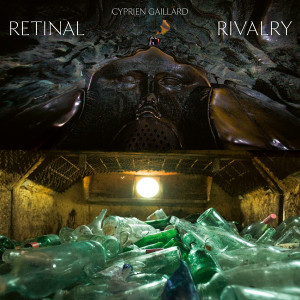
Soundtrack to Cyprien Gaillard’s new stereoscopic film, Retinal Rivalry (2024), is an entrancing journey through Germany’s urban landscape and its layers of historical and social significance.
It is an entrancing journey through Germany's urban landscape and its layers of historical and social significance. Building on his previous exploration of the sculptural qualities of three-dimensional moving images, the work extends beyond the confines of the screen. By harnessing cutting-edge technology to its full potential, Gaillard offers an expanded, sharpened and deeply affecting novel view of the world around us. Retinal Rivalry is named after the visual perception phenomenon that occurs when the brain receives two conflicting images at the same time. Instead of blending into one 3D image, the neural system alternates between prioritising one image while suppressing the other, causing confusion and discomfort for the viewer. Gaillard's film engages with these complexities of visual processing and the limitations of technology, collating visual information through exceptional, often tongue-in-cheek, shots that intertwine the inside and outside, the contained and dispersed, and the natural and built. His camera adopts unusual viewpoints, shifting from smooth aerial perspectives to a rodent's low gaze to the dizzying darting in and out on the bulbous nose of a sculpture, or a long shot of a train moving through a landscape, drawing us into a layered experience that teeters between a bad trip and unexpected beauty providing solace. Throughout Retinal Rivalry, various stairs, spirals and lifts allude to a state of constant ascent and descent, emphasising the interplay between distance and closeness, chasmic depth and vivid sculptural representation. The film rhythmically pulses with images that swell and contract, inflate and deflate. Manipulating viewers' sense of depth, scale and texture, it renders familiar materials and locations uncanny, highlighting the inherent inaccuracies and distortions of representation. Recording the ordinary world in magnificent detail while aiming to look beneath the surface of things, Retinal Rivalry is a depiction of space and time, destabilising modes of representation and offering a new hyper-vision version of reality. Shot at 120 frames per second and projected at the same ratefive times the standard rate in cinemaGaillard captures more than the human eye can naturally perceive. The film's score draws from diverse sonic elements, bolstering its exploration of dissonance and synchrony. Indonesian instrumental music is reworked and combined with field recordings of heavy machinery rumbling and strangely melodic retching. The soundtrack also incorporates the opening lines to Werner Herzog's Aguirre, the Wrath of God (1972), along with its accompanying overture by German band Popol Vuh. The soundscape of Retinal Rivalry contrasts its imageswhat we see is often at odds with what we hear. Only one section lets sound and image converge: a fractured leg pumps the pedal of an interactive organ to play a piece by Johann Sebastian Bach that repeatedly falters.